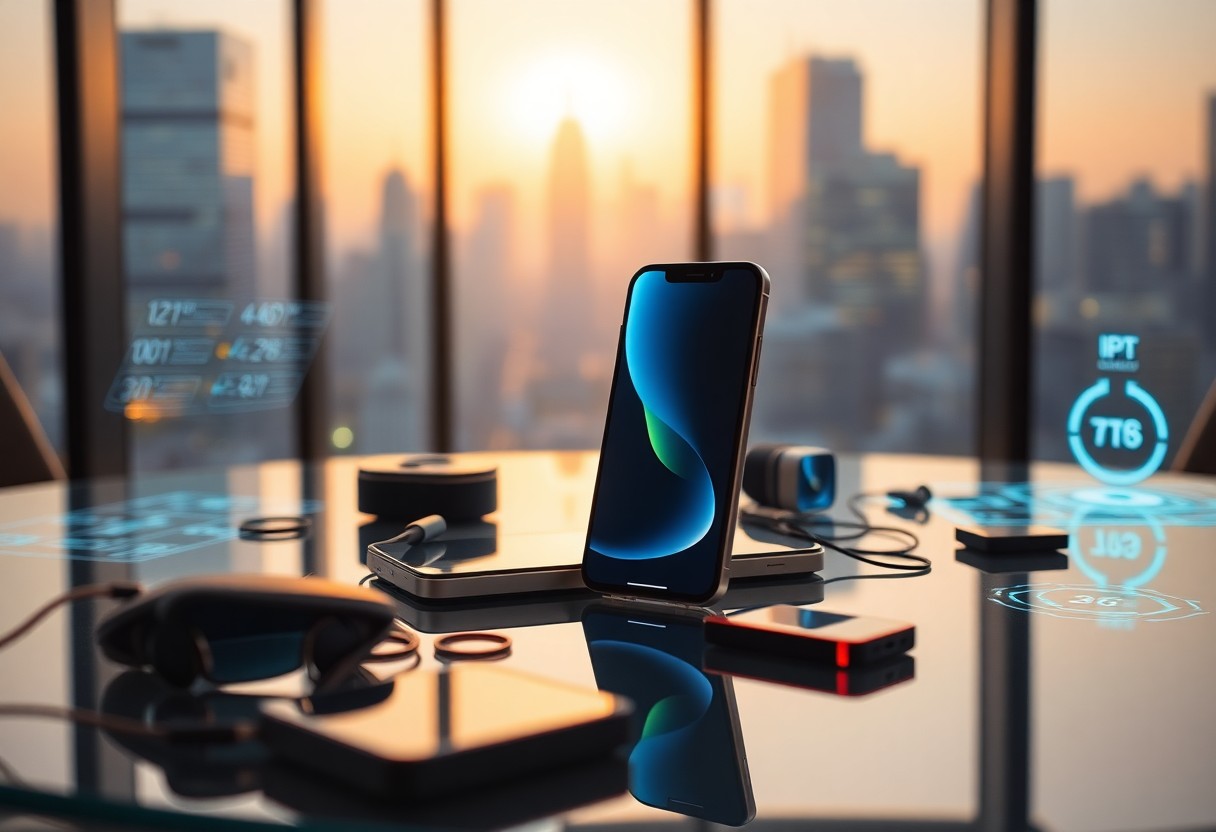Many technology enthusiasts are keenly observing the release of the iPhone 17 Pro, as it may signify a transformative leap in mobile computing. As you probe the features of this latest model, you’ll discover innovations that could reshape how you interact with your devices. With advancements in processing power, camera technology, and user experience, the iPhone 17 Pro could very well be a harbinger of the future you can expect in mobile technology. This post will explore what these developments mean for your everyday computing and connectivity.
The Game-Changing Features of the iPhone 17 Pro
The iPhone 17 Pro introduces an array of features that redefine what you expect from a mobile device. From enhanced photography capabilities to lightning-fast processing speeds, this model is unbelievably packed with innovations that elevate both functionality and usability. Its integration of cutting-edge technology positions it not just as a smartphone but as a pivotal tool for creativity, productivity, and entertainment. Get ready to explore how these features are set to transform your daily mobile experience.
Innovative Hardware Advancements
Experience a leap in performance with the iPhone 17 Pro’s new silicon technology. The A17 Bionic chip, featuring a 6-core CPU and 16-core GPU, delivers incredible speed and efficiency, enabling seamless multitasking and high-end gaming. With a brighter Super Retina XDR display that supports ProMotion technology, your visual experience becomes more immersive than ever, allowing you to enjoy vivid details in everything from graphics to text.
Enhanced User Experience through Software Integration
Apple’s latest iOS update complements the iPhone 17 Pro’s hardware, bringing you a refined user interface designed for effortless navigation. Features like Smart Focus and Live Text utilize real-time processing to streamline your interactions, making tasks easier and faster. With an emphasis on AI-driven solutions, your phone becomes intuitively adaptive to your preferences, providing suggested apps or information right when you need it.
Software integration on the iPhone 17 Pro goes beyond aesthetics; it fundamentally enhances productivity. With the capability of automatically organizing your apps based on usage patterns, you save time that might otherwise be lost scrolling through screens. Advanced machine learning models also optimize battery life by learning your daily habits, ensuring that your device keeps up with your routine without constant recharging. This synergy between hardware and software not only simplifies your life but also transforms how you utilize your device daily.

The Role of AI in Future Mobile Experiences
AI is set to revolutionize mobile computing by enhancing user experiences and streamlining daily tasks. Your smartphone will not only anticipate your needs but also adapt to your habits, creating a seamless digital environment. From voice recognition to intelligent personal assistants, AI is transforming how you interact with mobile technology, making each experience more intuitive and personalized.
Real-Time Processing and Machine Learning Applications
Real-time processing powered by machine learning is making your mobile devices smarter. This capability allows your applications to analyze and respond to data instantly, enabling features like instant translation, real-time navigation adjustments, and enhanced camera functionalities that can identify scenes and objects. As a result, your smartphone becomes an indispensable tool, streamlining everyday activities and improving user satisfaction.
Predictive Analytics and Personalization Trends
Predictive analytics in mobile computing allows your device to foresee your preferences and behaviors, thereby personalizing your experience. By analyzing your usage patterns and interactions, applications can suggest content, services, and even optimize settings just for you. This personalization not only enhances engagement but also makes navigating through apps and services more efficient, saving you time and effort.
The ongoing trend of predictive analytics is not merely a sales tactic; it’s a technology rooted in concrete data analysis. For instance, Netflix employs predictive algorithms that analyze your viewing habits to recommend shows tailored to your taste, ensuring you spend less time searching for content and more time enjoying it. Similarly, mobile shopping apps utilize your previous purchases and browsing history to tailor product suggestions, enhancing the likelihood of a purchase. These evolving personalization techniques ensure that your mobile device evolves with you, providing a unique and satisfying user experience that aligns closely with your individual needs.
The Environmental Impact and Sustainability of Mobile Devices
The increasing concern for environmental impact drives innovations in the design and production of mobile devices. Your choice of smartphone can affect everything from electronic waste to carbon emissions. As the industry evolves, a focus on sustainability is becoming vital to meet the demands of eco-conscious consumers, influencing both the materials used in devices and the practices of manufacturers.
Eco-Friendly Materials and Manufacturing Processes
Many tech companies, including Apple, have started integrating eco-friendly materials in their manufacturing processes. The iPhone 17 Pro reportedly utilizes 100% recycled aluminum in its casing, significantly reducing the depletion of natural resources. Using recycled materials not only lessens the environmental burden but also promotes a more responsible approach to production and consumerism.
The Shift Towards a Circular Economy in Tech
The shift towards a circular economy in tech emphasizes a sustainable lifecycle for mobile devices, reducing waste and encouraging recycling. Rather than a one-and-done production model, companies are exploring ways to reclaim materials from old devices for use in new ones, fostering a more sustainable method of consumption.
This circular economy model is gaining traction as consumers increasingly demand brands that prioritize sustainability. Companies are introducing programs that allow you to return your old devices for refurbishment or recycling, effectively minimizing e-waste. For instance, Apple’s Trade In program incentivizes you to return old devices, facilitating the recovery of valuable materials and reducing the need for new raw materials. This approach not only helps the environment but can also lead to cost savings for you as a consumer, making it a win-win situation as mobile technology evolves.
The Evolution of User Interface Design
User interface design has transformed significantly over the past decade, moving from simple touch interactions to sophisticated systems that anticipate your needs. You now enjoy interfaces that blend visual aesthetics with scalability and functionality, creating an immersive experience tailored to individual preferences. This evolution responds to your desire for more intuitive engagement, moving beyond static screens to fluid interactions that feel natural and engaging, revolutionizing how you connect with technology.
How the iPhone 17 Pro Redefines Interaction Paradigms
The iPhone 17 Pro introduces advanced haptic feedback and gesture recognition, allowing you to engage with your device in a more organic manner. These features enable multi-dimensional interactions, letting you navigate complex applications and multitask with ease. As you swipe, pinch, and tap, the phone intuitively adapts to your inputs, seamlessly adapting to your preferences while making every interaction feel fluid and responsive.
The Rise of Augmented Reality and Immersive Experiences
Augmented reality (AR) is at the forefront of enhancing your mobile experience, with the iPhone 17 Pro leveraging its powerful hardware capabilities to bring AR applications to life. This technology allows you to overlay digital information onto the real world, transforming how you engage with the environment around you. With features like spatial audio and advanced motion tracking, your interactions become more immersive and personal, opening doors to innovative applications in gaming, shopping, and even education.
The iPhone 17 Pro’s AR capabilities are a game changer, providing you with tools to experience environments like never before. Imagine trying on clothes virtually, visualizing furniture in your living room, or navigating through complex 3D models—all at your fingertips. With its advanced LiDAR sensor, the device offers unparalleled precision in understanding your surroundings, creating richer and more interactive experiences. As AR technology continues to evolve, your opportunities for engaging with digital content will expand, making everyday tasks more exciting and efficient.
Implications for Developers and Application Ecosystem
The iPhone 17 Pro signals significant shifts for developers and the application ecosystem, demanding creative and technical adaptations. Enhanced hardware capabilities, accelerated processing speeds, and advanced AI integration will empower developers to build more innovative and resource-intensive applications, creating experiences that were previously limited to desktops.
New Paradigms in App Development Due to Hardware Changes
With the iPhone 17 Pro’s advanced capabilities, you’ll likely see a shift towards more immersive and interactive applications. This device’s enhanced processing power and graphics performance allow developers to create visually stunning apps that leverage AR and VR technologies, transforming traditional user interactions and opening up entirely new avenues for creativity.
Opportunities for Entrepreneurs in Emerging Mobile Markets
Emerging mobile markets present unique opportunities for entrepreneurial ventures that capitalize on the advancements of the iPhone 17 Pro. As global smartphone adoption accelerates, faster networks and intelligent computing can unlock new business models, allowing startups to develop tailored applications that meet the specific needs of diverse populations.
Research shows that mobile penetration is growing rapidly in regions like Southeast Asia and Africa, where local entrepreneurs can leverage enhanced capabilities to create solutions addressing local challenges such as e-commerce, health services, and community engagement. For instance, a well-optimized app targeting agricultural efficiencies in a rural area or mobile banking solutions reacting to the financial landscape can have a transformative impact, thereby positioning your startup at the forefront of technological innovation. As the iPhone 17 Pro leads the charge in mobile advancements, understanding and tapping into these emerging markets will be crucial for your entrepreneurial success.
Conclusion
As a reminder, the iPhone 17 Pro showcases advancements that could shape the future of mobile computing. Its powerful performance, enhanced camera capabilities, and innovative features offer you a glimpse into what’s possible. As technology continues to evolve, staying informed about these developments will help you better navigate your digital experiences. The iPhone 17 Pro may indeed symbolize a significant shift, setting new standards that will impact how you use mobile devices for years to come.








